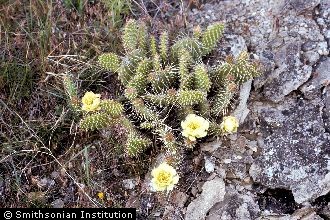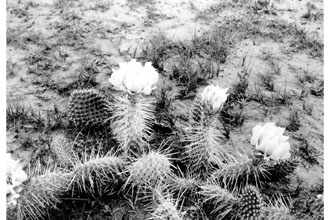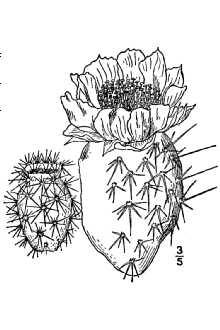Plains Pricklypear
Scientific Name: Opuntia polyacantha Haw.

| General Information | |
|---|---|
| Usda Symbol | OPPO |
| Group | Dicot |
| Life Cycle | Perennial |
| Growth Habits | Shrub |
| Native Locations | OPPO |
Plant Guide
Alternate Names
Common Names: Plains prickly-pear, hairspine cactus, starvation pricklypear, central pricklypear Scientific Names: none
Uses
Livestock: Plains pricklypear is palatable to livestock once the spines are removed (Mueller et al. 1994). In the Great Plains, plains pricklypear yields can range from 1,300 to 1,780 lb/ac. The spines of plains pricklypear however make it and other desirable vegetation growing underneath unavailable to livestock (Smith et al 1985). Digestibility of despined plains pricklypear measured at least equal to that of alfalfa hay. It has less digestible protein but more soluble carbohydrates than alfalfa. Supplementation with protein is recommended when providing a diet of plains pricklypear (Shoop et al. 1977). Wildlife: Plains pricklypear provides protection and cover for a variety of small mammals, reptiles, birds and insects. Other animals including bison, pronghorn and white-tailed deer eat plains pricklypear, especially after fire when the spines have been burned off (Courtney 1989; Peden 1976). Xeriscape: Plains pricklypear is easily propagated with cuttings and is popular for low water-use gardens and xeriscaping. The flowers are showy and last from late May to late June (Osborn et al. 1986). Pollinators: Numerous genera of native bees have been documented visiting plains pricklypear. Osborn et al. (1986) observed species of Diadasia, Lithurge, Melissodes, Bombus, Agapostemon and Megachile effectively pollinating plains pricklypear in southern Colorado. Ethnobotanical: Numerous tribes used plains pricklypear as a food source or as a drug. Cheyenne, Hopi and Montana Indians ate the fruit dried or fresh (Hart 1981; Nequatewa 1943; Blankinship 1905). The Goshute, Hopi and Paiutes also cooked and ate the fleshy stems (Chamberlin 1911; Whiting 1939; Fowler 1989). Stems and fruit were used to make dye (Hart 1992), and the spines were used to make fish hooks (Turner et al. 1980). The flesh of the stem joints was used by the Flathead to soothe backache, and the Okanagan-Colville applied a poultice of flesh to sores and infections (Hart 1992; Turner 1980).
Status
Please consult the PLANTS Web site and your State Department of Natural Resources for this plant’s current status (e.g., threatened or endangered species, state noxious status, and wetland indicator values).
Weediness
Plains pricklypear may become weedy or invasive in some regions or habitats and may displace desirable vegetation if not properly managed (Whitson et al. 1996). It is often a problem on overgrazed rangeland (Taylor and Whitson 1999). Please consult with your local NRCS Field Office, Cooperative Extension Service office, state natural resource, or state agriculture department regarding its status and use. Weed information is also available from the PLANTS Web site at http://plants.usda.gov/. Please consult the Related Web Sites on the Plant Profile for this species for further information.
Description
General: Plains pricklypear is a native perennial shrub with enlarged photosynthetic stem joints (cladophylls) which function as leaves (Harris and Harris 1997). The plants are mainly 1to 2 ft tall and can spread into wide colonies by layering and sprouting from fallen segments. The flattened stem joints are 2 to 6 inches long, obovate to orbicular, with numerous areoles (localized areas bearing spines). Each areole can bear from 0 to 18 spines, the longest typically averaging 1 to 6 inches in length depending on the variety (Holmgren et al. 2012). The flowers are large, 2 to 3.5 inches across, with numerous yellow, pink or violet petals. Natural Resources Conservation Service Plant Guide The fruit is a dry capsule (1 to 2 inches long) which splits upon maturity (Welsh et al. 2003). There are approximately 145,000 seeds per pound (USDA-NRCS 2014). Distribution: Plains pricklypear occurs throughout western North America. It can be found from British Columbia to southern California and east to Saskatchewan and south to Texas. For current distribution, please consult the Plant Profile page for this species on the PLANTS Web site. Habitat: Plains pricklypear occupies a broad range of habitats in western North America. It is found in cold desert shrublands in the Intermountain West and northern Great Plains and grows in association with sagebrush, horsebrush, rabbitbrush, western wheatgrass, bluebunch wheatgrass and Idaho fescue (Welsh et al. 2003). In the South and the shortgrass prairie it is common in blue grama, buffalo grass, threeawn, sand oak, yucca and mesquite communities (Shiflet 1994).
Adaptation
Plains pricklypear is adapted to arid and semi-arid regions receiving 8 to 20 inches annual precipitation at elevations from 1,000 to 8,000 feet (Johnson 2000). It can be found growing on fine to coarse textured soils but is not frequently found on sand dunes. It is moderately saline tolerant and is adapted to pH levels of 7.0 to 8.8 (USDA-NRCS 2014).
Establishment
Plains pricklypear is generally not used in rangeland seedings, but is more commonly established with cuttings for pollinator and low-water use gardens. See the “Seed and Plant Production” section for propagation details.
Management
Removal of plains pricklypear can increase forage availability (Hyde et al, 1965), It is often removed from rangelands by mechanical beaters, Mueller et al, Use soil moisture sensors to measure the soil moisture of Plains Pricklypear., (1994) proposed a mechanical harvester for plains prickly pear, They modified a side-delivery rake to uproot and windrow pricklypear which was then despined (Mueller and Forwood 1994) and fed to cattle, This provided an average of 1,040 lb/ac of cactus as potential feed, The removal of the cactus also increased the availability of desirable forage,
Pests and Potential Problems
The spines of plains pricklypear can make other desirable vegetation unavailable to livestock (Smith et al 1985). The spines are known to cause injury to the nose, mouth and tongues of livestock (Burrows and Tyrl 2001).
Environmental Concerns
Concerns
Concerns
The presence of plains pricklypear is often viewed as a sign of overgrazing. Colonies of plains pricklypear can provide physical protection to more desirable forage as livestock are hesitant to graze in its vicinity. It is unclear however if plains pricklypear increases on overgrazed rangeland or if it is merely more visible (Bemet 1968).
Control
Plains pricklypear can be controlled by mechanical or chemical means. The herbicide Picloram can be applied at 8 ounces (1/2 pint) or 16 ounces (1 pint) per acre. Apply at peak of flowering. Use of an oil-water emulsion spray mixture may improve control. Application of Picloram at the lower rate will provide partial control (stand reduction), and the high rate will provide more complete control. Treatment response is slow however and may take 2 years or more to see full effect (Taylor and Whitson 1999). Please contact your local agricultural extension specialist or county weed specialist to learn what works best in your area and how to use it safely. Always read label and safety instructions for each control method. Trade names and control measures appear in this document only to provide specific information. USDA NRCS does not guarantee or warranty the products and control methods named, and other products may be equally effective.
Seeds and Plant Production
Plant Production
Plant Production
Plants of plains pricklypear are typically established vegetatively using stem joint segments. Joints can be removed from established plants at any time of year. The joints should be dried for 2 to 3 days to allow a callus to form over the wound (Toogood 1999). Once callused, the cutting can be placed in a container or directly planted at the located site. Cuttings will root in 2 to 6 weeks. Flowering can occur in the first growing season. Establishment from seed is also successful, but seed takes 1 to 2 years to germinate and years to develop into mature plants. Cultivars, Improved, and Selected Materials (and area of origin) There are no releases of plains pricklypear. Common seed harvested from native stands is available commercially.
References
Bemet, R.E. 1968. Plains pricklypear: relation to grazing intensity and blue grama yield on Central Great Plains. Journal of Range Management. 21: 83-86. Blankinship, J.W. 1905. Native economic plants of Montana. Montana Agricultural College Experimental Station. Bulletin 56. Burrows. G.E. and R. J. Tyrl. 2001. Toxic Plants of North America. Iowa State Press. Ames, IA. 1342p. Chamberlin, R.V. 1911. The ethnobotany of the Gosiute Indians of Utah. Memoirs of the American Anthropological Association. 2(5): 331-405. Courtney, R.F. 1989. Pronghorn use of recently burned mixed prairie in Alberta. Journal of
Wildlife
Mangement. 53(2): 302-305. Fowler, C.S. 1989. Willards Z. Park’s Ethnographic Notes on the Northern Paiute of Western Nevada: 1933-1940. Salt Lake City. University of Utah Press. Harris, J.G. and M.W. Harris. 1997. Plant Identification Terminology: an Illustrated Glossary. Spring Lake Publishing. Spring Lake, UT. 194p. Hart, J.A. 1981. The Ethnobotany of the Northern Cheyenne Indians of Montana. Journal of Ethnopharmacology. 4: 1-55. Hart, J.A. 1992. Montana Native Plants and Early Peoples. Montana Historical Society Press. Helena, MT. Holmgren, N.H., Holmgren, P.K., Reveal, J.L. and collaborators. 2012. Intermountain Flora. Vascular Plants of the Intermountain West, U.S.A. Vol. 2, part A, subclasses magnoliidae-caryophyllidae. The New York Botanical Garden Press. New York, NY. 730p. Johnson, K.A. 2000. Opuntia polyacantha. In: Fire Effects Information System, [Online]. USDA-Forest Service, Rocky Mountain Research Station, Fire Sciences Laboratory. Mueller, D.M. and J.R. Forwood. 1994. Technical Note: Mechanical despining of plains pricklypear. Journal of Range Management. 47(5): 410-412. Mueller, D.M., Shoop, M.C., and W.A. Laycock. 1994. Technical Note: Mechanical harvesting of plains pricklypear for control and feeding. Journal of
Range
Management. 47(3): 251-254. Nequatewa, E. 1943. Some Hopi recipes for the preparation of wild plant foods. Plateau. 18: 18-20. Peden, D.G. 1976. Botanical composition of bison diets on shortgrass plains. The American Midland Naturalist. 96(1): 225-229. Shiflet, T.N. ed. 1994. Rangeland cover types of the United States. Society for Range Management. Denver, CO. 152p. Shoop, M.C., Alford, E.J., and H.F. Mayland. 1977. Plains pricklypear is a good forage for cattle. Journal of Range Mangement. 30(1): 12-17. Smith, M.A., Dodd, J.L. and J.D. Rodgers. 1985. Prescribed burning on Wyoming rangeland. Wyoming Agr. Res. Serv., Bull. 810. P 10-11. Taylor, W.R. and T.D. Whitson. 1999. Plains Prickly Pear Cactus Control. University of Wyoming Cooperative Extension Service, Bulletin #B-1074. Toogood, A. 1999. The American Horticultural Society: Plant Propagation. DK Publishing, Inc., New York, NY. Turner, N.J., Bouchard, R. and I.D. Dorothy. 1980. Ethnobotany of the Okanagan-Colville Indians of British Columbia and Washington. British Columbia Provincial Museum. [USDA NRCS] USDA Natural Resources
Conservation
Service. 2014. The PLANTS Database, version 3.5. URL: http://plants.usda.gov (accessed 21 Jan 2014). Baton Rouge (LA): National Plant Data Center. Welsh, S.L., Atwood, N.D., Goodrich, S. and L.C. Higgins. 2003. A Utah Flora. Brigham Young University. Provo, UT. 912p. Whiting, A.F. 1939. Ethnobotany of the Hopi. Museum of Northern Arizona, Bulletin #15. Whitson, T.D. (ed.) et al. 1996. Weeds of the West. Western Society of Weed Science in cooperation with Cooperative Extension Services, University of Wyoming. Laramie, Wyoming. Citation D. Tilley and L. St. John, L. 2013. Plant guide for plains pricklypear (Opuntia polyacantha). USDA-Natural Resources Conservation Service, Plant Materials Center, Aberdeen, Idaho 83210. Published February 2014 Edited: 23Jan2014 ls: 28Jan2014jab For more information about this and other plants, please contact your local NRCS field office or Conservation District at http://www.nrcs.usda.gov/ and visit the PLANTS Web site at http://plants.usda.gov/ or the Plant Materials Program Web site http://plant-materials.nrcs.usda.gov. PLANTS is not responsible for the content or availability of other Web sites.
Plant Traits
Growth Requirements
| Temperature, Minimum (°F) | -28 |
|---|---|
| Adapted to Coarse Textured Soils | Yes |
| Adapted to Fine Textured Soils | Yes |
| Adapted to Medium Textured Soils | Yes |
| Anaerobic Tolerance | None |
| CaCO3 Tolerance | High |
| Cold Stratification Required | No |
| Drought Tolerance | High |
| Fertility Requirement | Low |
| Fire Tolerance | None |
| Frost Free Days, Minimum | 200 |
| Hedge Tolerance | None |
| Moisture Use | Low |
| pH, Maximum | 8.8 |
| pH, Minimum | 7.0 |
| Planting Density per Acre, Maxim | 300 |
| Planting Density per Acre, Minim | 170 |
| Precipitation, Maximum | 20 |
| Precipitation, Minimum | 10 |
| Root Depth, Minimum (inches) | 12 |
| Salinity Tolerance | None |
| Shade Tolerance | Intolerant |
Morphology/Physiology
| Bloat | None |
|---|---|
| Toxicity | None |
| Resprout Ability | No |
| Shape and Orientation | Decumbent |
| Active Growth Period | Spring, Summer, Fall |
| C:N Ratio | High |
| Coppice Potential | Yes |
| Fall Conspicuous | No |
| Fire Resistant | No |
| Flower Color | Yellow |
| Flower Conspicuous | Yes |
| Foliage Color | Green |
| Foliage Porosity Summer | Porous |
| Foliage Porosity Winter | Porous |
| Foliage Texture | Coarse |
| Fruit/Seed Conspicuous | Yes |
| Nitrogen Fixation | None |
| Low Growing Grass | No |
| Lifespan | Moderate |
| Leaf Retention | Yes |
| Known Allelopath | No |
| Height, Mature (feet) | 2.0 |
| Height at 20 Years, Maximum (fee | 2 |
| Growth Rate | Rapid |
| Growth Form | Stoloniferous |
| Fruit/Seed Color | Red |
Reproduction
| Vegetative Spread Rate | Moderate |
|---|---|
| Small Grain | No |
| Seedling Vigor | Medium |
| Seed Spread Rate | Rapid |
| Fruit/Seed Period End | Fall |
| Seed per Pound | 145000 |
| Propagated by Tubers | No |
| Propagated by Sprigs | No |
| Propagated by Sod | No |
| Propagated by Seed | Yes |
| Propagated by Corm | No |
| Propagated by Container | Yes |
| Propagated by Bulb | No |
| Propagated by Bare Root | Yes |
| Fruit/Seed Persistence | No |
| Fruit/Seed Period Begin | Summer |
| Fruit/Seed Abundance | High |
| Commercial Availability | Contracting Only |
| Bloom Period | Late Spring |
| Propagated by Cuttings | Yes |
Suitability/Use
| Veneer Product | No |
|---|---|
| Pulpwood Product | No |
| Protein Potential | Medium |
| Post Product | No |
| Palatable Human | Yes |
| Palatable Graze Animal | Low |
| Palatable Browse Animal | Low |
| Nursery Stock Product | No |
| Naval Store Product | No |
| Lumber Product | No |
| Fodder Product | Yes |
| Christmas Tree Product | No |
| Berry/Nut/Seed Product | Yes |


